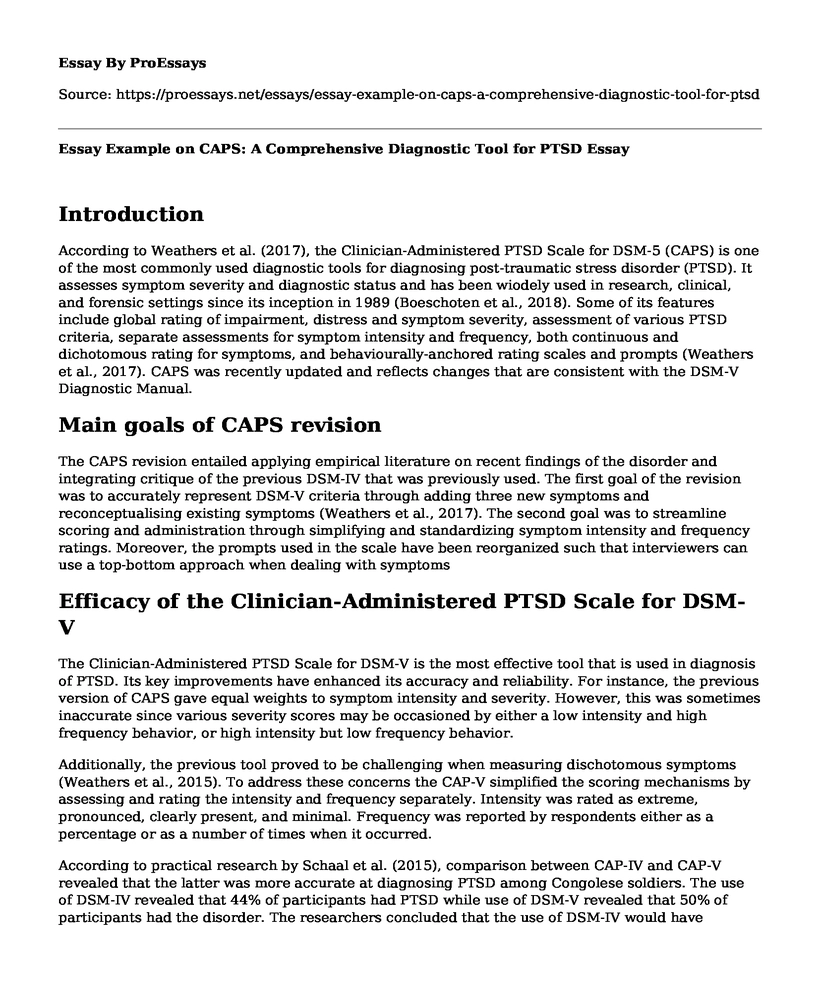Introduction
According to Weathers et al. (2017), the Clinician-Administered PTSD Scale for DSM-5 (CAPS) is one of the most commonly used diagnostic tools for diagnosing post-traumatic stress disorder (PTSD). It assesses symptom severity and diagnostic status and has been wiodely used in research, clinical, and forensic settings since its inception in 1989 (Boeschoten et al., 2018). Some of its features include global rating of impairment, distress and symptom severity, assessment of various PTSD criteria, separate assessments for symptom intensity and frequency, both continuous and dichotomous rating for symptoms, and behaviourally-anchored rating scales and prompts (Weathers et al., 2017). CAPS was recently updated and reflects changes that are consistent with the DSM-V Diagnostic Manual.
Main goals of CAPS revision
The CAPS revision entailed applying empirical literature on recent findings of the disorder and integrating critique of the previous DSM-IV that was previously used. The first goal of the revision was to accurately represent DSM-V criteria through adding three new symptoms and reconceptualising existing symptoms (Weathers et al., 2017). The second goal was to streamline scoring and administration through simplifying and standardizing symptom intensity and frequency ratings. Moreover, the prompts used in the scale have been reorganized such that interviewers can use a top-bottom approach when dealing with symptoms
Efficacy of the Clinician-Administered PTSD Scale for DSM-V
The Clinician-Administered PTSD Scale for DSM-V is the most effective tool that is used in diagnosis of PTSD. Its key improvements have enhanced its accuracy and reliability. For instance, the previous version of CAPS gave equal weights to symptom intensity and severity. However, this was sometimes inaccurate since various severity scores may be occasioned by either a low intensity and high frequency behavior, or high intensity but low frequency behavior.
Additionally, the previous tool proved to be challenging when measuring dischotomous symptoms (Weathers et al., 2015). To address these concerns the CAP-V simplified the scoring mechanisms by assessing and rating the intensity and frequency separately. Intensity was rated as extreme, pronounced, clearly present, and minimal. Frequency was reported by respondents either as a percentage or as a number of times when it occurred.
According to practical research by Schaal et al. (2015), comparison between CAP-IV and CAP-V revealed that the latter was more accurate at diagnosing PTSD among Congolese soldiers. The use of DSM-IV revealed that 44% of participants had PTSD while use of DSM-V revealed that 50% of participants had the disorder. The researchers concluded that the use of DSM-IV would have produced 3% of false positives and 8% of false negatives as compared to the DSM-V statistical tool.
Conclusion
Based on the analysis of the Clinician-Administered PTSD Scale for DSM-5 (CAPS), it is the most effective tool that can be used to diagnose PTSD in patients. In addition to its reliability and accuracy, the weaknesses that were present in CAPS-IV were improved to enhance its usage. It was standardized and streamlined to give accurate scores on symptom severity and intensity so that patients could be more accurately diagnosed with PTSD. Empirical research by Schaal et al. (2015) validated these views by revealing that the DSM-IV criteria produced more false positives and false negatives in diagnosis of PTSD as compared to the application of the DSM-V tool. It is therefore clear that the Clinician-Administered PTSD Scale for DSM-5 (CAPS) is the most accurate diagnostic tool in treating PTSD.
References
Boeschoten, M. A., Van der Aa, N., Bakker, A., Ter Heide, F., Hoofwijk, M. C., Jongedijk,
R. A., ... Olff, M. (2018). Development and Evaluation of the Dutch Clinician-Administered PTSD Scale for DSM-5 (CAPS-5). European Journal of Psychotraumatology, 9(1), 1546085. doi:10.1080/20008198.2018.1546085
Department of Veteran Affairs. (2019). PTSD: National Center for PTSD: Clinician-Administered PTSD Scale for DSM-5 (CAPS-5). Retrieved from https://www.ptsd.va.gov/professional/assessment/adult-int/caps.asp
Schaal, S., Koebach, A., Hinkel, H., & Elbert, T. (2015). Posttraumatic stress disorder according to DSM-5 and DSM-IV diagnostic criteria: a comparison in a sample of Congolese ex-combatants. European Journal of Psychotraumatology, 6, 24981. doi:10.3402/ejpt.v6.24981
Weathers, F. W., Blake, D. D., Schnurr, P. P., Kaloupek, D. G., Marx, B. P., & Keane, T. M. (2015). The Clinician-Administered PTSD Scale for DSM-5 (CAPS-5) - Past Week [Measurement instrument]. Retrieved from https://www.ptsd.va.gov/
Weathers, F. W., Bovin, M. J., Lee, D. J., Sloan, D. M., Schnurr, P. P., Kaloupek, D. G., ...
Marx, B. P. (2017). The Clinician-Administered PTSD Scale for DSM-5 (CAPS-5): Development and initial psychometric evaluation in military veterans. Psychological Assessment, 30(3), 383-395. doi:10.1037/pas0000486
Cite this page
Essay Example on CAPS: A Comprehensive Diagnostic Tool for PTSD. (2023, Jan 11). Retrieved from https://proessays.net/essays/essay-example-on-caps-a-comprehensive-diagnostic-tool-for-ptsd
If you are the original author of this essay and no longer wish to have it published on the ProEssays website, please click below to request its removal:
- Research Paper on Sociology: Mate Selection
- Personality Analysis - Michael Jackson
- Paper Example on Assessing Mental Health in Older Adults
- Stress Management Annotated Bibliography
- Essay on Caring for Adolescents and Young Adults: Addressing Risks With Therapeutic Interventions
- Paper Sample on Who Cares and So What? Understanding the Real-World Impact of Your Writing
- Stress and Resilience in the Work Place - Essay Sample







